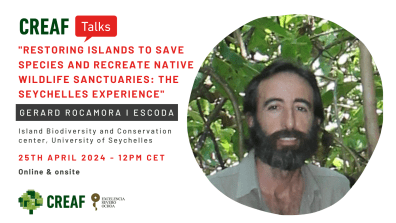Restoring islands to save species and recreate native wildlife sanctuaries: the Seychelles experience
TITLE: "Restoring islands to save species and recreate native wildlife sanctuaries: the Seychelles experience"
DATE: Thursday, 25th April 2024.
TIME & FORMAT: form 12 to 1pm CET - In-person and online.
Seminars will combine in-person and online formats (CREAF, Sala Graus II, Universitat Autònoma de Barcelona, Spain) but in all cases, talks will be always streamed (not recorded), so they can be followed online.
HOW TO CONNECT: direct link to the conference.
SUMMARY OF THE WORKSHOP:
Islands represent only 5% of the global land area but concentrate about 20% of global biodiversity, and over 85% of documented vertebrate extinctions have occurred on islands. Human colonisation has been responsible for the introduction of invasive species such as rats and cats, which have exterminated endemic species, and for habitat destruction, these being the two main threats to biodiversity globally. To save species threatened with extinction, many small islands of Seychelles have benefited from restoration projects to eradicate or control introduced predators and competitors, eliminate invasive vegetation, multiply native trees and (re)introduce animal species that will speed up ecosystem recovery. In Seychelles, more than 25 islands have benefited from such restoration activities, resulting in the eradication of about 50 invasive vertebrate populations from islands, and the translocation of more than 40 populations of native animals, of which several that have been rescued from near-extinction and are no longer considered globally threatened. In these islands, many species of plants and animals have benefited from these restoration activities, increasing significantly in numbers and range already after some years, or having spontaneously recolonised the islands in the case of certain seabirds.
ABOUT THE SPEAKER:
Gerard Rocamora is Docteur-Ingénieur en Agronomie specialised in ecology (Institut Agro Montpellier - Université des Sciences et Techniques du Languedoc, Montpellier & Universitat de Barcelona, 1987). His main expertise and areas of interest include birds and other terrestrial vertebrates, invasive species and particularly rodents. He has worked in Europe, Africa, tropical America and the western Indian Ocean with organisations such as BirdLife International and its French partner LPO, IUCN, Conservation International, CEPF and government institutions including the Seychelles Ministry of Environment. Naturalised Seychellois, this conservation biologist and practitioner with origins from Catalonia (Spain) and Southern France, works in Seychelles since 1995 on threatened species recovery and island rehabilitation programmes, ecosystem monitoring and seabirds. He has contributed to c.30 invasive alien species management programmes, leading 20 successful vertebrate eradications (mainly rodents) on islands, and to a dozen of successful reintroductions and other translocations of threatened birds and reptiles. Having been affiliated for 20 years to the Muséum National d’Histoire Naturelle (CRBPO & SPN/ UMR 7204), he has contributed to three specialist groups of the Species Survival Commission of IUCN (Invasive Species/Translocations/Red Data List). He is also a bird ringer currently licensed by SAFRING (Cape Town University). Member of the former Academic committee of the University of Seychelles, Associate Senior Lecturer in Environmental Sciences since 2013, he supervises regularly MSc and PhD students. He is the initiator of the Island Biodiversity & Conservation centre, a co-founder of the Island Conservation Society, and also an environmental adviser for private islands or companies. He is fluent in half-a-dozen languages and has authored or co-authored about 120 scientific and technical publications including 3 books and 8 chapters on threatened species and priority sites for conservation, c.50 peer-reviewed articles in scientific journals and conference proceedings, c.50 species monographies; plus articles in international wildlife magazines, chapters in popular books, and several wildlife sound guides.


